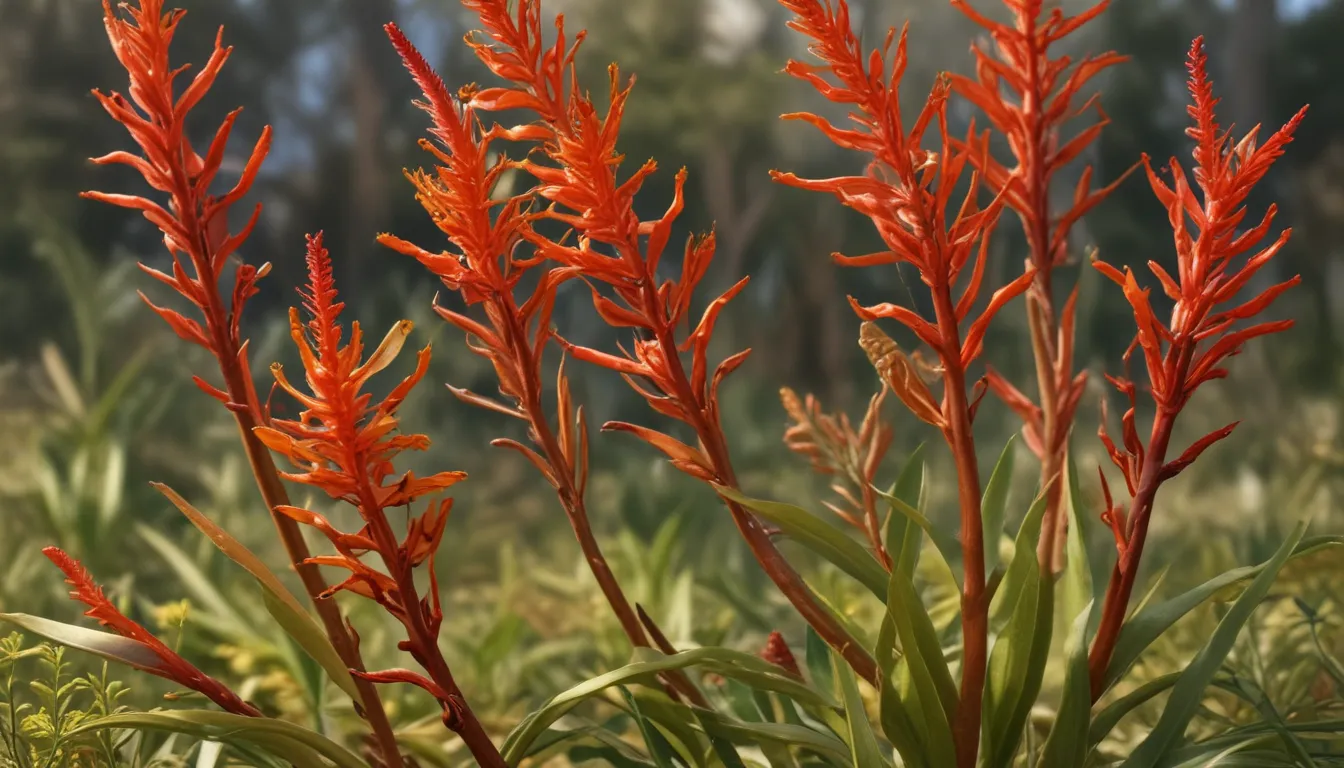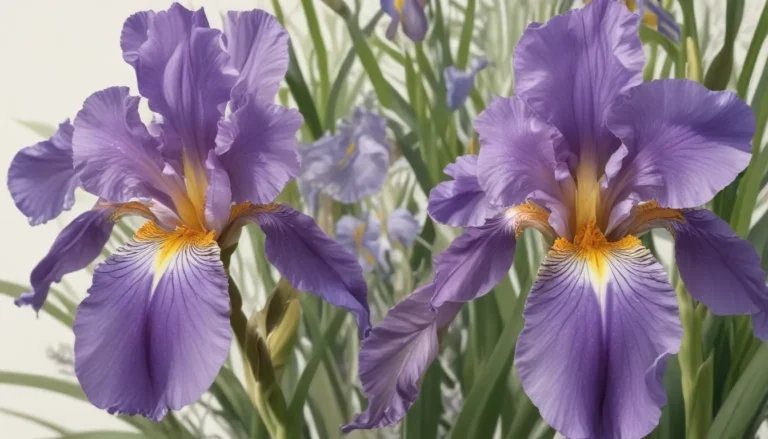The pictures we use in our articles might not show exactly what the words say. We choose these pictures to make you interested in reading more. The pictures work together with the words but don’t take their place. The words still tell you the important facts.
Are you ready to embark on a journey through the vibrant world of Kangaroo Paw? This unique plant, scientifically known as Anigozanthos, hails from the picturesque landscapes of Western Australia. With its captivating flower that mirrors the delicate paw of a kangaroo, Kangaroo Paw is more than just a visually stunning addition to your garden. Join us as we unravel 16 fascinating facts about this extraordinary plant, from its origin to its cultural significance and ecological importance.
A Closer Look at Kangaroo Paw
Kangaroo Paw dazzles with its intricate flowers that come in an array of vibrant colors such as red, yellow, and orange. Its unique appearance adds a touch of charm to any garden or floral arrangement, making it a beloved choice for plant enthusiasts worldwide.
Embracing Its Australian Roots
Native to the southwestern regions of Australia, Kangaroo Paw thrives in sandy or well-drained soils, perfectly adapted to the Mediterranean climate of its homeland. Its resilience to droughts and fires showcases its remarkable ability to survive and thrive in challenging environments.
Nature’s Drought Warrior
One of Kangaroo Paw's most admirable traits is its exceptional drought tolerance. With specialized roots that store water, this plant can endure long periods without rainfall, making it a popular choice for gardens in arid regions.
A Haven for Wildlife
The alluring shape and colors of Kangaroo Paw flowers serve as a beacon for various bird species, including honeyeaters, who delight in the plant's sweet nectar. Bees also play a vital role in pollinating the flowers, ensuring the cycle of life continues in harmony.
Bridging Cultures
Kangaroo Paw holds deep cultural significance for the Aboriginal people of Australia. Beyond its ornamental beauty, this plant is used for traditional practices such as basket weaving and medicinal purposes, highlighting its multifaceted role in indigenous communities.
Blooms That Last
With a blooming period that stretches from spring to early winter, Kangaroo Paw bestows gardens with a kaleidoscope of colors throughout the year. Its extended flowering time adds a splash of vibrancy to any outdoor space.
Nature’s Firefighter
Evolved to withstand the Australian ecosystem, Kangaroo Paw boasts natural resistance to fire. Its underground rhizomes spring to life post-fire, ensuring the plant's survival and regeneration, a testament to its tenacity.
Effortlessly Elegant
Kangaroo Paw is a low-maintenance plant that requires minimal watering and pruning, making it an ideal choice for both novice and experienced gardeners. Its pest and disease resistance further cement its status as a hassle-free favorite.
From Garden to Bouquet
The captivating flowers of Kangaroo Paw make it a sought-after choice for cut flower arrangements. Adding an Australian touch to bouquets and floral displays, this plant exudes elegance and charm in any setting.
Landscaping Marvel
Versatile in landscaping, Kangaroo Paw can be utilized as ground cover, borders, or ornamental features in gardens. When planted in groups or alongside native Australian flora, its vibrant blooms create a captivating visual spectacle.
Name’s Origin
The whimsical name "Kangaroo Paw" stems from the flower's uncanny resemblance to the paw of a kangaroo. The tubular flowers with curved lobes mirror the iconic image, encapsulating the essence of this enchanting plant.
Fluttering Wings of Beauty
Butterflies are among the enchanting visitors drawn to the bright, nectar-rich flowers of Kangaroo Paw. Their presence adds an extra layer of beauty to gardens adorned with this captivating plant.
A Portable Paradise
Ideal for small gardens, balconies, and patios, Kangaroo Paw's adaptability to containers allows urban gardeners to revel in its beauty. No space is too small to enjoy the allure of this unique plant.
Healing Touch
Certain species of Kangaroo Paw are believed to possess medicinal properties. Historically used by Aboriginal communities to treat various ailments, this plant offers a holistic approach to well-being and healing.
Buzzing with Life
In addition to bees and butterflies, Kangaroo Paw attracts beneficial insects like hoverflies and ladybugs. These natural predators help maintain a balanced ecosystem in the garden, keeping pests at bay while enhancing biodiversity.
Hybrid Delights
Through breeding techniques, a dazzling array of hybrid Kangaroo Paw varieties has emerged, offering a kaleidoscope of colors and flower shapes for garden enthusiasts to choose from. A testament to the plant's versatility and beauty.
Nature’s Masterpiece
In conclusion, Kangaroo Paw stands as a testament to nature's creativity and resilience. From its striking resemblance to a kangaroo's paw to its ecological benefits and ease of care, this plant embodies the perfect blend of beauty and functionality.
Frequently Asked Questions (FAQs)
Q: What are the ideal growing conditions for Kangaroo Paw?
A: Kangaroo Paw thrives in well-draining soil, full sun exposure, and moderate temperatures, making it especially suited to coastal climates.
Q: How often should I water Kangaroo Paw?
A: Regular watering during the growing season is essential to keep the soil evenly moist. However, avoid overwatering to prevent root rot.
Q: Are Kangaroo Paw plants invasive?
A: No, Kangaroo Paw is well-behaved and not considered invasive, making it a safe choice for gardeners.
Q: Can Kangaroo Paw be grown in containers?
A: Yes, Kangaroo Paw adapts well to containers as long as good drainage is provided, offering urban gardeners a touch of nature in limited spaces.
Q: When is the best time to prune Kangaroo Paw?
A: Pruning after flowering is recommended to remove dead flowers and maintain the plant's shape, ensuring its health and vitality.
As you marvel at the wonders of Kangaroo Paw, consider delving into the realm of other fascinating flowers and plants. From the majestic Giant Bird of Paradise to the delicate Brunnera, each plant tells a unique story waiting to be discovered. Nature's tapestry is vast and diverse, offering endless opportunities for exploration and learning.
Conclusion: Embrace the Beauty of Kangaroo Paw
Whether you're a seasoned gardener or an admirer of nature's wonders, Kangaroo Paw presents an enchanting glimpse into the world of botanical marvels. Its aesthetic appeal, ecological benefits, and cultural significance make it a treasure worth nurturing in any garden or landscape setting. As you revel in the vibrancy of Kangaroo Paw, remember to cherish the beauty and resilience of nature that surrounds us every day.
Unveiling the Enigmatic Kangaroo Paw: Explore Nature’s Delightful Treasure
Are you ready to embark on a journey through the vibrant world of Kangaroo Paw? This unique plant, scientifically known as Anigozanthos, hails from the picturesque landscapes of Western Australia. With its captivating flower that mirrors the delicate paw of a kangaroo, Kangaroo Paw is more than just a visually stunning addition to your garden. Join us as we unravel 16 fascinating facts about this extraordinary plant, from its origin to its cultural significance and ecological importance.
A Closer Look at Kangaroo Paw
Kangaroo Paw dazzles with its intricate flowers that come in an array of vibrant colors such as red, yellow, and orange. Its unique appearance adds a touch of charm to any garden or floral arrangement, making it a beloved choice for plant enthusiasts worldwide.
Embracing Its Australian Roots
Native to the southwestern regions of Australia, Kangaroo Paw thrives in sandy or well-drained soils, perfectly adapted to the Mediterranean climate of its homeland. Its resilience to droughts and fires showcases its remarkable ability to survive and thrive in challenging environments.
Nature’s Drought Warrior
One of Kangaroo Paw's most admirable traits is its exceptional drought tolerance. With specialized roots that store water, this plant can endure long periods without rainfall, making it a popular choice for gardens in arid regions.
A Haven for Wildlife
The alluring shape and colors of Kangaroo Paw flowers serve as a beacon for various bird species, including honeyeaters, who delight in the plant's sweet nectar. Bees also play a vital role in pollinating the flowers, ensuring the cycle of life continues in harmony.
Bridging Cultures
Kangaroo Paw holds deep cultural significance for the Aboriginal people of Australia. Beyond its ornamental beauty, this plant is used for traditional practices such as basket weaving and medicinal purposes, highlighting its multifaceted role in indigenous communities.
Blooms That Last
With a blooming period that stretches from spring to early winter, Kangaroo Paw bestows gardens with a kaleidoscope of colors throughout the year. Its extended flowering time adds a splash of vibrancy to any outdoor space.
Nature’s Firefighter
Evolved to withstand the Australian ecosystem, Kangaroo Paw boasts natural resistance to fire. Its underground rhizomes spring to life post-fire, ensuring the plant's survival and regeneration, a testament to its tenacity.
Effortlessly Elegant
Kangaroo Paw is a low-maintenance plant that requires minimal watering and pruning, making it an ideal choice for both novice and experienced gardeners. Its pest and disease resistance further cement its status as a hassle-free favorite.
From Garden to Bouquet
The captivating flowers of Kangaroo Paw make it a sought-after choice for cut flower arrangements. Adding an Australian touch to bouquets and floral displays, this plant exudes elegance and charm in any setting.
Landscaping Marvel
Versatile in landscaping, Kangaroo Paw can be utilized as ground cover, borders, or ornamental features in gardens. When planted in groups or alongside native Australian flora, its vibrant blooms create a captivating visual spectacle.
Name’s Origin
The whimsical name "Kangaroo Paw" stems from the flower's uncanny resemblance to the paw of a kangaroo. The tubular flowers with curved lobes mirror the iconic image, encapsulating the essence of this enchanting plant.
Fluttering Wings of Beauty
Butterflies are among the enchanting visitors drawn to the bright, nectar-rich flowers of Kangaroo Paw. Their presence adds an extra layer of beauty to gardens adorned with this captivating plant.
A Portable Paradise
Ideal for small gardens, balconies, and patios, Kangaroo Paw's adaptability to containers allows urban gardeners to revel in its beauty. No space is too small to enjoy the allure of this unique plant.
Healing Touch
Certain species of Kangaroo Paw are believed to possess medicinal properties. Historically used by Aboriginal communities to treat various ailments, this plant offers a holistic approach to well-being and healing.
Buzzing with Life
In addition to bees and butterflies, Kangaroo Paw attracts beneficial insects like hoverflies and ladybugs. These natural predators help maintain a balanced ecosystem in the garden, keeping pests at bay while enhancing biodiversity.
Hybrid Delights
Through breeding techniques, a dazzling array of hybrid Kangaroo Paw varieties has emerged, offering a kaleidoscope of colors and flower shapes for garden enthusiasts to choose from. A testament to the plant's versatility and beauty.
Nature’s Masterpiece
In conclusion, Kangaroo Paw stands as a testament to nature's creativity and resilience. From its striking resemblance to a kangaroo's paw to its ecological benefits and ease of care, this plant embodies the perfect blend of beauty and functionality.
Frequently Asked Questions (FAQs)
Q: What are the ideal growing conditions for Kangaroo Paw?
A: Kangaroo Paw thrives in well-draining soil, full sun exposure, and moderate temperatures, making it especially suited to coastal climates.
Q: How often should I water Kangaroo Paw?
A: Regular watering during the growing season is essential to keep the soil evenly moist. However, avoid overwatering to prevent root rot.
Q: Are Kangaroo Paw plants invasive?
A: No, Kangaroo Paw is well-behaved and not considered invasive, making it a safe choice for gardeners.
Q: Can Kangaroo Paw be grown in containers?
A: Yes, Kangaroo Paw adapts well to containers as long as good drainage is provided, offering urban gardeners a touch of nature in limited spaces.
Q: When is the best time to prune Kangaroo Paw?
A: Pruning after flowering is recommended to remove dead flowers and maintain the plant's shape, ensuring its health and vitality.
As you marvel at the wonders of Kangaroo Paw, consider delving into the realm of other fascinating flowers and plants. From the majestic Giant Bird of Paradise to the delicate Brunnera, each plant tells a unique story waiting to be discovered. Nature's tapestry is vast and diverse, offering endless opportunities for exploration and learning.
Whether you're a seasoned gardener or simply an admirer of nature's beauty, Kangaroo Paw invites you to embrace its enchanting world. Let its vibrant colors, cultural significance, and ecological importance inspire you to cultivate a deeper connection with the natural wonders that surround us. As you bask in the beauty of Kangaroo Paw, remember to cherish and protect the biodiversity that enriches our lives every day.






